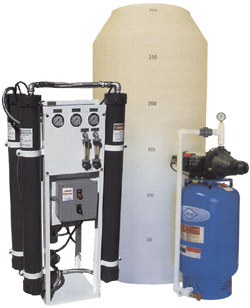Reverse Osmosis Filtration
Reverse Osmosis
The reverse osmosis process uses a semi-permeable membrane to separate and remove dissolved solids, organics, pyrogens, sub micron colloidal matter, viruses and bacteria from water. The process is called “Reverse” Osmosis since it requires pressure to force pure water across a membrane, leaving the impurities behind. Reverse Osmosis is capable of removing 95-99% of the total dissolved solids (TDS) and 99% of all bacteria, thus providing safe, pure water.

Capabilities of a Reverse Osmosis System
A reverse osmosis system consists of Pretreatment, the reverse osmosis unit, and in some cases post-treatment, depending on the use of the RO water. Activated carbon post-treatment filtration is used when the system is to supply drinking water. the reverse osmosis membrane can’t tolerate high concentrations of iron, manganese, hydrogen sulfide, hardness or turbidity. Therefore, pretreatment is essential to the performance of the RO system. An RO unit combined with activated carbon filtration is capable of reducing the entire spectrum of impurities found in drinking water, including organic and inorganic contaminants.
